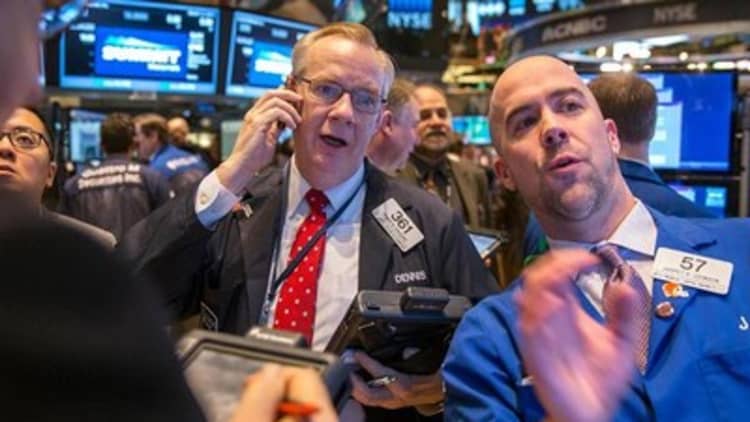
Consumer inflation is expected to have edged higher in February, but the gain could be small and potentially fleeting.
"We're going to have the first increase in the headline since October and the first gain in energy prices since July," said Deutsche Bank's chief U.S. economist, Joseph LaVorgna. "Oil prices were up a little bit last month. With oil weakening a little bit in the last few days, it's hard to say how sustainable that upswing will be in the next few months."
LaVorgna expects to see CPI up 0.2 percent when it is reported at 8:30 a.m. ET Tuesday, compared to a decline of 0.7 percent for January. Economists project core CPI—without food and energy—to have risen 0.1 percent.
Besides CPI, there are new home sales at 10 a.m., expected to be down more than 4 percent, and Markit flash manufacturing PMI at 9:45 a.m. The FHFA home price index is released at 9 a.m.
Markets though will pay closest attention to any change in inflation, which has been stubbornly low. The Fed expects to see inflation gradually rise toward its 2 percent target but so far it is sputtering. The central bank's preferred inflation gauge—the PCE deflator—is released Monday.
Fed Vice Chairman Stanley Fischer, in remarks Monday, reiterated the central bank's view on slowly rising inflation and said it is likely to raise rates this year. Market opinion is mixed on whether the Fed will wait to see stronger signs of inflation before raising interest rates.
Read MoreFischer: Fed fund rate increase likely this year; 'no plans' for regular hikes
Last week, the Fed signaled it was on a path to raise rates in the near future. It also lowered its economic forecasts, cut its inflation outlook and changed its estimated timeline on rate hikes. The market has greater expectations now that the central bank will move to hike rates for the first time in September, though Fed officials continue to stress that June is possible.
Markets on Monday continued to adjust to the Fed's latest announcements, which sent the dollar reeling after its meeting last Wednesday. The U.S. currency was lower again, and strategists say the Fed could have pushed it into a short-term correction, but the longer-term trend remains higher.
"I think the most important leading indicators (on inflation) will be the CRB and the dollar. Watch them and they'll point us in the right direction," said Ward McCarthy, chief financial economist at Jefferies. The Thomson Reuters/Core Commodity CRB is an index of 19 commodities, and it bounced when the dollar fell last week.
"The low was on March 18, and we've been ticking up since then. You're at the low end of a pretty ugly bear market," said McCarthy. The CRB has been trading at a six-year low.
He said the Fed is looking for flexibility. "They want to be in a position where if some one thing suggests we're getting inflation and something suggests we're not, it doesn't hamstring them," McCarthy said.
Read MoreAn eighth of a point Fed rate hike? Seriously?
MacNeil Curry, global head of technical strategy at Bank of America Merrill Lynch, said it appears the CRB index did bottom on the day of that Fed meeting March 18, along with other markets.
"You have a lot of conditions for it. It looks like a bullish reversal. Gold did it too," said Curry. "You saw a bunch of stuff start to indicate a squeeze to the topside."
Curry said the gains by the euro, yen and pound against the dollar appear to be short-term trends. His target for the euro is $1.10 to $1.11 on the upside and $1.04 should be the bottom of the current range. The euro was trading above $1.09 to the dollar Monday.
Read MoreWhy housing has a supply problem
The rallies in the Australian and New Zealand dollars and gold, however, appear to be medium-term trends and could continue, he said. Curry has a target of $1,307/$1,345 per ounce for gold. Gold futures were at $1,188 per ounce late Monday.
"I think Treasurys put in a medium-term yield top and that's why the dollar is likely to suffer as well," said Curry. The high yield on the 10-year was 2.26 percent, and on Monday, it was yielding 1.91 percent.
Treasury yields declined on apprehension about Greece's debt talks Monday. They also were lower as Fischer repeated the Fed's dovish message—it will raise rates but slowly.
Read MoreUS gas prices fall 4 cents, ending weeks of increases: Survey
Curry is eyeing 2,145 as a target on the S&P 500, but he added the market could pull back temporarily before it reaches that level.
Stocks were lower Monday, with the S&P down 3 at 2104, while fell 11 to 18,116. The Dow transports, led by rails, were sharply lower, off nearly 2 percent to 8,968. and the Nasdaq was down 15, at 5,010.
Biotechs, winners for nine sessions, reversed course Monday. The iShares Nasdaq Biotech ETF IBB fell 2.25 percent.


